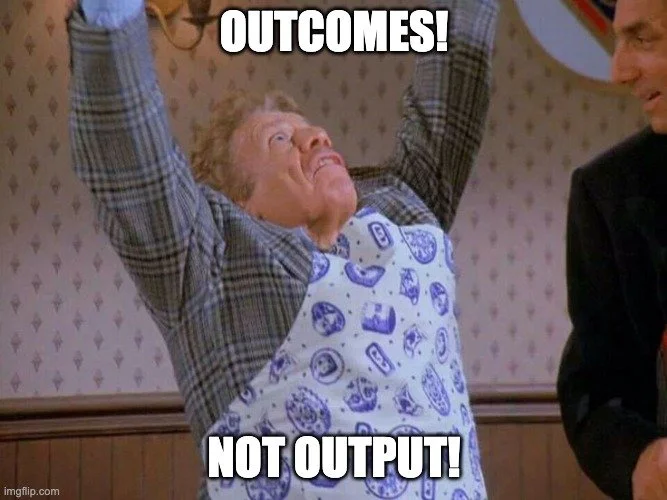AI is an Output, Not an Outcome, People!
This article first appeared in Medium.
If you’re in product management or work with product folks, you’ve had the “outcomes, not output” mantra drilled into your head… perhaps ad nauseam. While it may be annoying to hear product managers parrot this during meetings like a “SERENITY NOW!” mantra, it’s still valid. In fact, it’s more relevant than ever. Why? Enter the AI craze.
As a product leader, I’ve seen firsthand how easy it is to get caught up in tech hype, often leading to a focus on outputs rather than meaningful outcomes. I’m old enough to have seen several tech and UX hype cycles involving blockchain, IoT, AR, gamification, etc., crest and dissipate into practical applications like waves on the shore. While AI is the most profound tech advancement in the last few decades (at least), all these technologies represent progress for businesses, economies, and the human race. Where companies stumble is when these become buzzwords, and leaders ask teams to pursue solutions without first focusing on the problem to solve.
Generative AI isn’t the first (or last) time we’ve seen irrational exuberance around emerging tech. But the stakes have never been higher. Every business strategy suddenly needs an AI component, or investors assume you’re falling behind. This output focus doesn’t guarantee meaningful customer, business, or employee achievements by simply throwing AI into your product. But before we go further, let’s ensure we all have the same understanding when discussing outputs vs. outcomes.
Outputs are the tangible results of our efforts — the features we ship, the tools we implement, or the products we launch. Conversely, outcomes are the measurable impacts that outputs have on our business goals and user experiences. The outcome should answer the “why” for building a new product or feature. In the context of AI, an output might be implementing an AI-powered chatbot, while an outcome would be a measurable improvement in customer satisfaction scores or increased sales.
Like every other technological breakthrough, we need to shift our focus from implementation and integration to impact to truly leverage the new technology. We must ask ourselves: How will this technology improve the customer experience, employee effectiveness, or business performance? At the end of the day, why are we doing this?
How Might We Focus AI on Outcomes?
There are some obvious outcomes that — depending on the specific circumstances — line up nicely for AI to potentially be a part of the solution. Efficiency gains, data analysis, and personalization are just a few areas that are getting attention.
Efficiency/productivity gains: Where there are repetitive tasks, content generation, or ideation, achieving an efficient outcome is possible. For example, leveraging generative AI tools may help reduce the time product managers spend doing user research or developing a Jobs-to-be-Done framework.
Data analysis: The outcome in this space could be measurable efficiency gains and more effective analysis that lead to insights and better business performance. For example, you could export your NPS survey data as a CSV file, upload it to an LLM, and have it analyze your top 5 customer complaints.
Personalization: Personalization might be the most interesting out of these examples. Effective personalization leads to better customer engagement, conversion, retention, and value. Clearly, as technology advances, personalization’s potential only grows and is far from hitting a ceiling.
For a real-world personalization example, take Stitch Fix, a service I’ve used in the past. It’s a personal styling agent that uses AI to analyze customer preferences and generate personalized styles. I will say that while the styles can sometimes be hit or miss, I have found that I purchase more of the recommendations than I assumed I would. So much so that I occasionally pause the service just to give my wallet a break! However, note that Stitch Fix’s use of AI as a core component of their product has not guaranteed long-term success, as proven by their up and down performance in a highly competitive space. Their performance reinforces that AI alone is not a business strategy that by itself sustains a bottom line.
Taking personalization further, Generative AI, in particular, opens up a world of endless opportunities, revolutionizing customer experiences and driving business growth. Generative AI can create new, unique content tailored to each user. The proliferation of personalized content will be massive. It may make the proliferation of niche cable channels, customized playlists, targeted social media posts and tailored online ads seem quaint by comparison. Infinite personalized content will soon become our new — if not somewhat distorted — reality. The ramifications of a completely “personalized” reality are probably worthy of their own blog post — but that’s for another day.
Regardless of how quickly infinite, personalized content becomes the norm, companies must be smart about leveraging generative AI to create engaging experiences. AI could become a firehose for creating content; it will be necessary to point it in the right direction (and with the right amount of force!). The key is keeping the customer at the center and being intentional about the outcomes this drives while simultaneously not bombarding us with personalized content across the entirety of someone’s digital journey.
Beyond the Hype
AI is a revolutionary technology that has made incredible advances in the past few years; it will be integral to advancing personalized, impactful experiences that drive tangible business outcomes. But at least from a product management perspective, we need to focus on the problem to solve and the outcome to achieve for our customers first instead of treating AI as a solution in search of a problem.
So, let’s move beyond the hype and focus on the transformative potential of AI to create meaningful, measurable value for our users and our organizations. Just remember, customers don’t care about your “AI strategy” when it comes to the tech driving your products — they have a problem to solve — a job to be done. If we keep focusing on both the customer and the problem to solve, maybe… just maybe you’ll hear a product person repeating that annoying product management catchphrase a little less in the future: it’s outcomes, not output, people!

